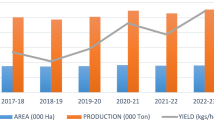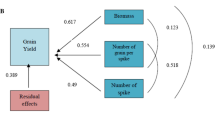Abstract
In order to assess efficiency of drought tolerance indices, 50 bread wheat genotypes were evaluated under three environments: normal (clay fertile soil, E1), 100% (E2), and 50% (E3) field water capacity in sandy calcareous soil. A total of 14 drought tolerance indices including grain yield/plant, grain yield/spike, 1000-kernel weight, spike length, no. of tillers, plant height, flowering time, stomata frequency, stomata width, stomata length, drought susceptibility index (DSI), stress tolerance index (STI), yield stability index (YSI), and harmonic mean (HM) were estimated. A moderate to high broad-sense heritability was obtained for 1000-kernel weight (0.47), spike length (0.38), plant height (0.54), flowering time (0.73), stomata frequency (0.59), and stomata length (0.54). Grain yield/plant was strongly positively correlated with grain yield/spike, no. of tillers, plant height, flowering time, stomata length, STI, YSI, and HM, while negatively correlated with stomata frequency and DSI in E2 and E3, respectively. Thus, highly heritable traits strongly correlated with grain yield under stress conditions especially stomata frequency and length could be used as reliable indices for selecting high-yielding genotypes tolerant to drought stress. Cluster analysis based on morpho-physiological traits suggested the group 3 genotypes in E2 as the most tolerant genotypes to be used for developing improved varieties.
Similar content being viewed by others
References
Ahsan M, Hader MZ, Saleem M, Aslam M. 2008. Contribution of various leaf morpho-physiological parameterstowards grain yield in maize. Int. J. Agr. Biol. 10: 546–550
Akçura M, Partigoç F, Kaya Y. 2011. Evaluating of drought stress tolerance based on selection indices in Turkish bread wheat landraces. J. Anim. Plant Sci. 21: 700–709
Badieh MMS, Farshadfar E, Haghparast R, Rajabi R, Zarei L. 2012. Evaluation of gene actions of some traits contributing in drought tolerance in bread wheat utilizing diallel analysis. Ann. Biol. Res. 3: 3591–3596
Barker TC, Campos H, Cooper M, Dolan D, Edmeades GO, Habben J, Schussler J, Wright D, Zinselmeier C. 2005. Improving drought tolerance in maize. Plant Breed. Rev. 25: 173–253
Bhargava S, Sawant K. 2013. Drought stress adaptation: metabolic adjustment and regulation of gene expression. Plant Breed. 132: 21–32
Bkagwat SG, Bhatia CR. 1993. Selection for flag leaf stomata frequency in bread wheat. Plant Breed. 110: 129–136
Blake NK, Lanning SP, Martin JM, Sherman JD, Talbert LE. 2007. Relationship of flag leaf characteristics to economically important traits in two spring wheat crosses. Crop Sci. 47: 491–494
Bouslama M, Schapaugh WT. 1984. Stress tolerance in soybean. Part 1: Evaluation of three screening techniques for heat and drought tolerance. Crop Sci. 24: 933–937
Campos H, Cooper M, Habben JE, Edmeades GO, Schussler JR. 2004. Improving drought tolerance in maize: a view from industry. Field Crops Res. 90: 19–34
Clarke JM, DePauw RM, Townley-Smith TF. 1992. Evaluation of methods for quantification of drought tolerance in wheat. Crop Sci. 32: 728–732
Cooper M, van Eeuwijk F, Chapman SC, Podlich DW, Loeffler C. 2006. Genotype-by-environment interactions under water-limited conditions. In JM Ribaut, ed, Drought Adaptation in Cereals, Haworth NY, pp 51–96
Dencic S, Kastori R, Kobiljski B, Duggan B. 2000. Evaluation of grain yield and its components in wheat cultivars and landraces under near optimal and drought conditions. Euphytica 113: 43–52
Drikvand R, Doosty B, Hosseinpour T. 2012. Response of rainfed wheat genotypes to drought stress using drought tolerance indices. J. Agric. Sci. 4: 126–131
Edmeades GO. 2013. Progress in achieving and delivering drought tolerance in maize- an update, ISAAA, Ithaca, NY
Ehdaie B, Shakiba MR. 1996. Relationship of internode-specific weight and water-soluble carbohydrates in wheat. Cereal Res. Commun. 24: 61–67
Farshadfar E, Ghannadha M, Zahravi M, Sutka J. 2001. Genetic analysis of drought tolerance in wheat. Plant Breed. 114: 542–544
Farshadfar E, Moradi Z, Elyasi P, Jamshidi B, Chaghakabodi R. 2012. Effective selection criteria for screening drought tolerant landraces of bread wheat (Triticum aestivum L.). Ann. Biol. Res. 3: 2507–2516
Fernandez GCJ. 1992. Effective selection criteria for assessing plant stress tolerance. In CG Kuo, ed, Proceedings of the international symposium on adaptation of vegetables and other food crops in temperature and water stress, Publication, Tainan, Taiwan
Fischer RA, Maurer R. 1978. Drought resistance in spring wheat cultivar I: Grain yield responses. Aust. J. Agric. Res. 29: 897–912
Fleury D, Jefferies S, Kuchel H, Langridge P. 2010. Genetic and genomic tools to improve drought tolerance in wheat. J. Exp. Bot. 61: 3211–3222
Gaskell ML, Pearce RB. 1983. Stomata frequency and stomata resistance of maize hybrids differing in photosynthetic capability. Crop Sci. 23: 176–177
Golabadi M, Arzani A, Maibody SAM. 2006. Assessment of drought tolerance in segregating populations in durum wheat. Afr. J. Agric. Res. 5: 162–171
Golestani M, Pakniat H. 2007. Evaluation of drought tolerance indices in sesame lines. J. Sci, technol. Agric. Nat. Resour. 41: 141–149
Guttieri MJ, Stark JC, Brien K, Souza E. 2001. Relative sensitivity of spring wheat grain yield and quality parameters to moisture deficit. Crop Sci. 41: 327–335
Iftikhar R, Khaliq I, Kashif M, Ahmad MA, Smiullah. 2012. Study of morphological traits affecting grain yield in wheat (Triticum aestivum L.) under field stress condition. Middle East J. Sci. Res. 11: 19–23
Jatoi WA, Baloch MJ, Kumbhar MB, khan NU, Kerio MI. 2011. Effect of water stress on physiological and yield parameters at anthesis stage in elite spring wheat cultivars. Sarhad J. Agric. 27: 332–339
Khan AS, Ul Allah S, Sadique S. 2010. Genetic variability and correlation among seedling traits of wheat (Triticum aestivum) under water stress. Int. J. Agric. Biol. 12: 247–250
Kristin AS, Senra RR, Perez FI, Enriquez BC, Gallegos JA, Vallego PR, Wassimi N, Kelley JD. 1997. Improving common bean performance under drought stress. Crop Sci. 37: 43–50
Lonbani M, Arzani A. 2011. Morpho-physiological traits associated with terminal drought stress tolerance in triticale and wheat. Agron. Res. 9: 315–329
Mitra J. 2001. Genetics and genetic improvement of drought resistance in crop plants. Curr. Sci. 80: 58–762
Mohammadi M, Karimizadeh R, Abdipour M. 2011. Evaluation of drought tolerance in bread wheat genotypes under dryland and supplemental irrigation conditions. Aust. J. Crop Sci. 5: 487–493
Mohammadi R, Farshadfar E, Aghaee M, Shutka J. 2003. Locating QTLs controlling drought tolerance criteria in rye using disomic addition lines. Cereal Res. Commun. 31: 257–263
Muhe K. 2011. Selection index in durum wheat (Triticum turgidum var. durum) variety development. Acad. J. Plant Sci. 4: 77–83
Nyquist WE. 1991. Estimation of heritability and prediction of selection response in plant populations. Crit. Rev. Plant Sci. 10: 235–322
Omara MK. 1994. Collection, maintenance and gene banking of germplasm of wheat, barley, berseem clover, maize and sorghum from moisture deficient areas in Upper Egypt. Final Report of project No. A-5-4 NARP, Egypt
Quarrie SA, Jones HG. 1977. Effects of abscistic acid and water stress on development and morphology of wheat. J. Exp. Bot. 28: 192–203
Rohlf FJ. 1998. NTSYSpc: Numerical Taxonomy and Multivariate Analysis System. Version 2.02. Exeter Software, Setauket, New York
Rosielle AA, Hamblin J. 1981. Theoretical aspects of selection for yield in stress and non-stress environments. Crop Sci. 21: 943–946
Saba J, Moghaddam M, Ghassemi K, Nishabouri MR. 2001. Genetic properties of drought resistance indices. J. Agric. Sci. Technol. 3: 43–49
Saint Pierre CS, Crossa JL, Bonnett D, Yamaguchi-Shinozaki K, Reynolds MP. 2012. Phenotyping transgenic wheat for drought resistance. J. Exp. Bot. 63: 1799–1808
Singh S, Sethi GS. 1995. Stomata size, frequency and distribution in Triticum aestivum, Secale cereale and their amphiploids. Cereal Res. Commun. 23: 103–108
Sio-Se Mardeh A, Ahmadi A, Poustini K, Mohammadi V. 2006. Evaluation of drought resistance indices under various environmental conditions. Field Crop Res. 98: 222–229
Tabatabaei SA. 2013. Study relationship of drought tolerance indices in wheat (Triticum aestivum) genotypes. Int. J. Biosci. 3: 15–22
Talebi R. 2011. Evaluation of chlorophyll content and canopy temperature as indicators for drought tolerance in durum wheat (Triticum durum Desf.). Aust. J. Basic Appl. Sci. 5: 1457–1462
Venora G, Calcagno F. 1991. Study of stomata parameters for selection of drought resistant varieties in Triticum Durum Desf. Euphytica 57: 275–283
Wang H, Clarke JM. 1993a. Genotypic, intra plant and environmental variating in stomata frequency and size in wheat. Can. J. Plant Sci. 73: 671–678
Wang H, Clarke JM. 1993b. Relationship of excised-leaf water-loss and stomata frequency in wheat. Can. J. Plant Sci. 73: 93–99
Xu Z, Zhou G. 2008. Responses of leaf stomata density to water status and its relationship with photosynthesis in a grass. J. Exp. Bot. 59: 3317–3325
Yang HM, Wang GX. 2001. Leaf stomatal densities and distribution in Triticum aestivum under drought and CO2 enrichment. Chin J. Plant Ecol. 25: 312–316
Zhang YP, Wang ZM, Wu YC, Zhang X. 2006. Stomata characteristics of different green organs in wheat under different irrigation regimes. Acta Agron. Sin. 32: 70–75
Author information
Authors and Affiliations
Corresponding author
Rights and permissions
About this article
Cite this article
El-Rawy, M.A., Hassan, M.I. Effectiveness of drought tolerance indices to identify tolerant genotypes in bread wheat (Triticum aestivum L.). J. Crop Sci. Biotechnol. 17, 255–266 (2014). https://doi.org/10.1007/s12892-014-0080-7
Received:
Revised:
Accepted:
Published:
Issue Date:
DOI: https://doi.org/10.1007/s12892-014-0080-7




